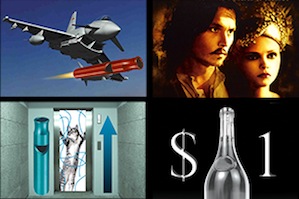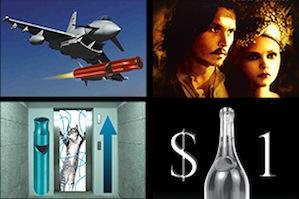
“Rhapsody” was a well-planned, competently performed, yet insufficiently documented concert by the Gold Coast Chamber Players at the Lafayette Library on Saturday evening. The title fit well, even though there was only one work called a rhapsody on the program. While the Oxford English Dictionary definition of rhapsody is “a free musical composition, usually emotional or exuberant in character,” it is the word’s earlier and now obsolete meaning, the pulling together of a potpourri of various elements into a recitation, that told the story, since three of the first four works programmed were suitelike in character, and the remaining one was George Enescu’s Romanian Rhapsody No. 1, a surefire way to energize an audience.
Attractive incidentals graced the event. A reception with the artists followed the performance, and two paintings by Moraga artist Camille Young stood on easels at either side of the stage. Artistic Director and violist Pamela Freund-Striplen explained them to the audience before the concert began. Sensuale, on the left, is, with its bare suggestion of the outline of a string instrument, a depiction of the Gold Coast Players. Young was inspired by Enescu’s music to paint Rhapsody, on the right. It’s an abstract, showing wavy colored lines (the rippling Danube?) intertwined with spiral streamers.
George Enescu’s Romanian Rhapsody No. 1, a surefire way to energize an audience.
But the 16-page brochure handed to patrons had no program notes, only a listing of the works to be performed, with no dates of composition. While up to half a page was devoted to each performer and composer, only a sentence at most mentioned the featured pieces, if they were mentioned at all. The absence of work-specific information was noted by attendees, two of whom complained about it in my presence.
Jet Set
The concert began with Heitor Villa-Lobos’ three-movement Assobio a Játo (The jet whistle), nicely played by flutist Stephanie McNab, accompanied by cellist Victoria Ehrlich. Internet research reveals that the piece was written 1950 and given its unusual title because of the instruction given in the last-movement’s flute part to blow directly, instead of tangentially, into the mouthpiece. Combined with a glissando, the resulting sound is supposed to sound like a jet flying overhead. It didn’t, though it might resemble a robotized drone jetlet of the future. Nevertheless, the melodic first, the dreamy second, and the oompah-ish third movements were highly diverting.
In my book, there’s nothing better than playing some juicy samples of upcoming unfamiliar music.
Program notes were unnecessary for the second piece, since composer Martin Rokeach was there to explain all from the stage. He told us that Going Up?, for flute, viola, and cello, was written for members of an ensemble with the memorable moniker of “Eight Strings and a Whistle.” Then, very kindly, he asked Gold Coast members to play the work’s two “climbing themes” and a more complex flute theme, which he cleverly characterized as a call saying, “I’m up; come on up!” In my book, there’s nothing better than playing some juicy samples of upcoming unfamiliar music, and the audience responded favorably seven minutes later at the end of Rokeach’s melodious, infectiously rhythmic, and well-constructed piece.
The first half of the concert concluded with the 1992, four-movement Suite for violin, clarinet, and piano by the Armenian composer Alexander Arutiunian (b. 1920). The fine tone of Corina Stoian’s violin technique was a chief attraction of this set, which began with a six-minute “Introduction” featuring a lugubrious violin opening and a nostalgic clarinet part. The 3/4-time scherzo seemed a bit slow to me. It was followed by a very brief “Dialog” for violin and clarinet before the five-minute “Finale,” which featured catchy metric divisions of the bar and a short melodic middle section for the clarinet. It was the best movement of the bunch and warmed up the audience considerably.
The short second half of the program began with Osvaldo Golijov’s suite of three excerpts from Sally Potter’s 2000 film The Man Who Cried: “Lullaby,” “Doina,” and “Gallop.” It might have been helpful for the audience to know that Golijov designed “Lullaby” to fit in counterpoint with Bizet’s aria “Je Crois Entendre” from The Pearl Fishers, also used in the film, and that Golijov admitted about the theme of the concluding “Gallop” that “I stole [it] from my friends of the wild gypsy band Taraf de Haïdouks.” Like most of Golijov’s work, this was fine music, marred in only a couple of places by intonation problems.
Enescu’s 1901 Rhapsody has always been a guilty pleasure of mine, and the Gold Coast’s arrangement of string sextet and piano did not disappoint me or the audience. Stoian herself hails from Romania and seemed to have coached her fellow performers to fine effect. If it had been even more over-the-top, I might have enjoyed it even more, but I’m not complaining.
If only the program notes had mentioned that the first tune in Enescu’s potpourri was a pop song of the time, in English translation bearing the line “I have a dollar, and I’m ready to drink!” Likewise, the Gold Coasters certainly had an appreciative audience, and were ready to play.

